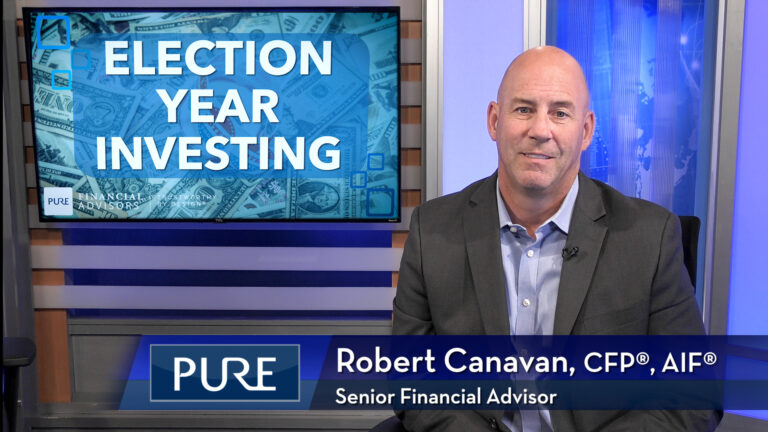When it comes to taxes, planning ahead is key, it’s a year-round commitment that ties into your retirement vision. Pure’s Financial Advisor, Ryan Miiller, CFP®, AIF®, analyzes the newest tax updates for 2024 and show you how they fit into your personal financial journey.
FREE GUIDE | 2024 Tax Planning Guide
Transcript
For the first time in five years, the deadline for filing 2023 federal income tax returns to the traditional date: April 15. So be sure not miss the deadline, it can be costly!
The penalty for late filing is 5% of the amount due each month, and the penalty for failure to pay is 0.5% a month, maxing out at 25% a year.
You can file for an extension which gives you an additional six months which would be on October 15, 2024. If you believe you will owe taxes, you must estimate how much you owe and pay that amount due when you file the extension form.
You may be eligible to prepare and file federal income tax returns for free online, if your adjusted gross income is AGI is $79,000 or less, using guided tax preparation software through IRS Free File or if you are a service member through MilTax if you meet the requirements.
If you are using a paid tax preparer, check their qualifications and credentials using the IRS directory of federal tax return preparers. Ask about service fees and be wary of preparers who boast about getting bigger refunds than their competition.
If you think you may receive a refund, electronically filing and choosing direct deposit is the fastest way to get your refund. When using direct deposit, the IRS normally issues refunds within 21 days. Issuance of a paper check refunds may take much longer.
Watch out for tax scams!
Scammers usually target you by impersonating the IRS to get you to share your personal information with them. The IRS does not initiate contact with taxpayers by email, text messages, or social media channels to request personal or financial information.
Now looking into the future, here are the top tax updates for 2024. In general tax brackets have been adjusted for inflation upward around 5.4%. So, what does this mean?
For married filing jointly the upward end of the 12% tax bracket increases from $89,450 to $94,300. This means you can earn more income and stay in the same tax bracket.
The standard deduction increases from $13,850 to $14,600 for single filers, and $27,700 to $29,200 for married couples filing jointly. If you do not itemize, this increases the amount of income exempt from taxes.
The annual contribution limit for traditional IRAs and Roth IRAs increases $500 to $7,000. The catch-up limit for individuals aged 50 and older remains at $1,000.
The annual contribution limit for a 401(k), 403b or TSP and other retirement plans increases $500 to $23,000. The catch-up limit for individuals aged 50 and older will remain at $7,500.
The annual gift tax exclusion increases $1,000. This means you now can gift up to $18,000 a year to any individual without triggering a gift tax.
The Social Security annual earnings limit for those who are receiving benefits before their full retirement age increases from $21,240 to $22,320.
The annual qualified charitable distribution limit increases $5,000 to $105,000 per person. This is the maximum amount you can transfer from your taxable IRA directly to a church or charity and avoid paying income tax on the distribution. This transfer also may satisfy your required minimum distribution (RMD) for the year.
Tax rates on long-term capital gains and qualified dividends remain the same but the income limits increase. For couples filing jointly taxable income can be as high as $94,050 and remain in the 0% capital gains tax bracket.
Strategic tax planning should be year-round and integrated with your overall retirement goals in mind. If you’d like help to identify ways to offset your gains and limit the amount of money you pay in taxes, take advantage of our free tax analysis.
Subscribe to our YouTube channel.
IMPORTANT DISCLOSURES:
• Investment Advisory and Financial Planning Services are offered through Pure Financial Advisors, LLC, a Registered Investment Advisor.
• Pure Financial Advisors LLC does not offer tax or legal advice. Consult with your tax advisor or attorney regarding specific situations.
• Opinions expressed are subject to change without notice and are not intended as investment advice or to predict future performance.
• Investing involves risk including the potential loss of principal. No investment strategy can guarantee a profit or protect against loss in periods of declining values.
• All information is believed to be from reliable sources; however, we make no representation as to its completeness or accuracy.
• Intended for educational purposes only and are not intended as individualized advice or a guarantee that you will achieve a desired result. Before implementing any strategies discussed you should consult your tax and financial advisors.
CFP® – The CERTIFIED FINANCIAL PLANNER™ certification is by the Certified Financial Planner Board of Standards, Inc. To attain the right to use the CFP® designation, an individual must satisfactorily fulfill education, experience and ethics requirements as well as pass a comprehensive exam. Thirty hours of continuing education is required every two years to maintain the designation.
AIF® – Accredited Investment Fiduciary designation is administered by the Center for Fiduciary Studies fi360. To receive the AIF Designation, an individual must meet prerequisite criteria, complete a training program, and pass a comprehensive examination. Six hours of continuing education is required annually to maintain the designation.














